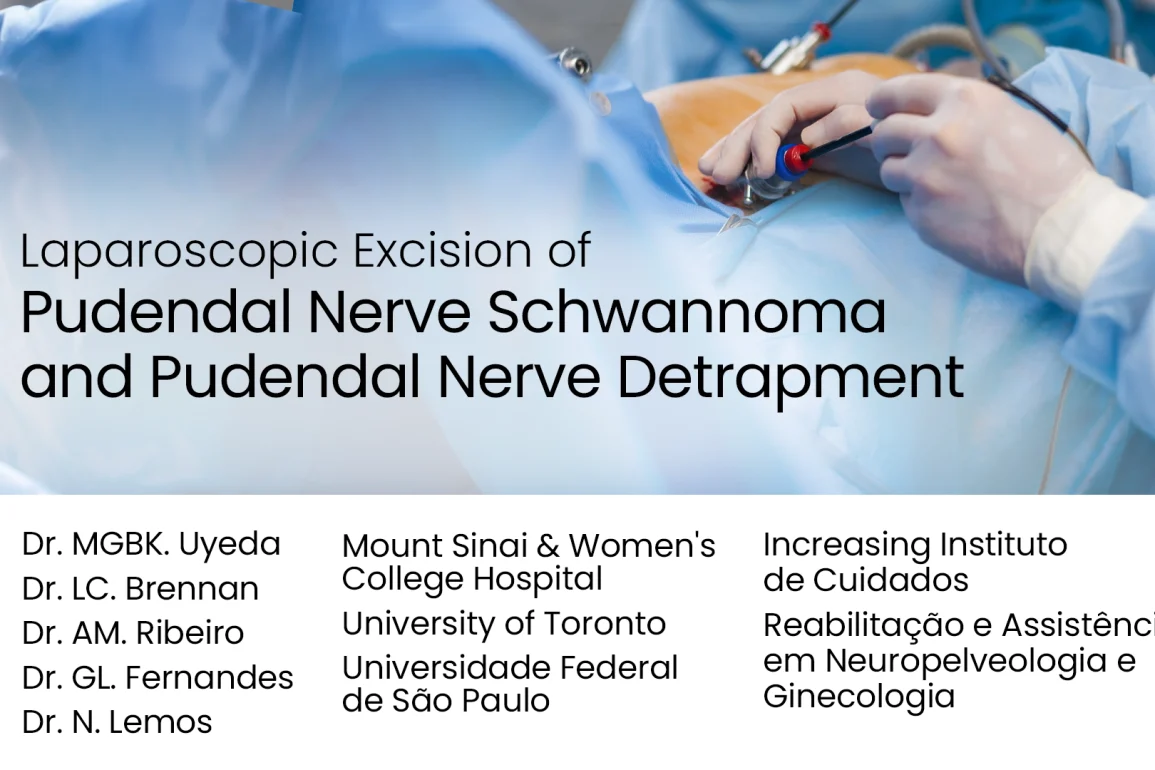Table of Contents
- Procedure Summary
- Authors
- Youtube Video
- What is a Laparoscopic Excision of Pudendal Nerve Schwannoma and Pudendal Nerve Detrapment?
- What are the Risks of Laparoscopic Excision of Pudendal Nerve Schwannoma and Pudendal Nerve Detrapment?
- Video Transcript
Video Description
To present a unique case presentation featuring the laparoscopic placement of a secondary cervico-isthmic abdominal cerclage during a trichorionic triamniotic (TCTA) pregnancy. Notably, the procedure reveals an incidental finding of uterine dehiscence, subsequently addressed through the placement of a uterine omental patch. This video provides a comprehensive overview of the pertinent anatomy and key surgical steps involved in placing a transabdominal cerclage during a 12 week TCTA pregnancy through narrated illustrations and video footage. Uterine dehiscence and extrusion of placenta from triplet A is identified and repaired. The procedure was uncomplicated and the patient delivered 3 healthy infants by cesarean-hysterectomy at 33 weeks gestation. The laparoscopic placement of a uterine omental patch represents a novel technique for repair of uterine dehiscence during pregnancy. Its consideration should be based on the patient’s reproductive history, and acknowledgment for the limited long-term studies regarding this technique.
Presented By

Dr. LC Brennan

Dr. GL Fernandes


Affiliations
Mount Sinai & Women’s College Hospital
Universty of Toronto
Universidade Federal de Sao Paulo
Increasing Instituto de Cuidados
Reabilitacao e Assisencia em Neuropelveologia e Ginecologia
Watch on YouTube
Click here to watch this video on YouTube.
What is Laparoscopic Excision of Pudendal Nerve Schwannoma and Pudendal Nerve Detrapment?
What are the Risks of Laparoscopic Excision of Pudendal Nerve Schwannoma and Pudendal Nerve Detrapment?
The laparoscopic excision of a pudendal nerve schwannoma and pudendal nerve detrapment carries specific risks due to the complex anatomy of the pelvic region and the sensitivity of the pudendal nerve. Here are the primary risks:
-
Nerve Damage: Manipulating or removing tissue around the pudendal nerve may result in temporary or permanent nerve damage, potentially causing numbness, weakness, or altered sensation in the pelvic area.
-
Chronic Pain: In some cases, patients may experience persistent or worsened pelvic pain (neuropathic pain) after surgery, as the procedure can sometimes lead to nerve irritation or sensitization.
-
Infection and Bleeding: Like any surgery, there is a risk of infection or bleeding at the incision sites or within the pelvic region, which could require additional treatment or prolong recovery.
-
Bladder and Bowel Dysfunction: The pudendal nerve plays a role in controlling bladder and bowel function. Surgical intervention could disrupt these functions, potentially leading to incontinence or other difficulties.
-
Scar Tissue Formation (Adhesions): Scar tissue can form around the nerve or pelvic structures post-surgery, potentially causing pelvic pain or requiring future intervention if adhesions affect organ or nerve function.
-
Conversion to Open Surgery: In complex cases, it may be necessary to switch from laparoscopy to open surgery if visualization or access is inadequate, which could lead to a longer recovery time.
These risks highlight the importance of an experienced surgical team and thorough preoperative planning to mitigate complications and achieve the best possible outcomes for symptom relief.
Video Transcript: Laparoscopic Excision of Pudendal Nerve Schwannoma and Pudendal Nerve Detrapment
In this video, we will present a laparoscopic excision of a pudendal nerve schwannoma. This 56-year-old female patient presented with pain in the deep right glutaeal muscle and posterior thigh. She complained of an itching or tickling sensation, and a shock like sensation to the right labia majora, in addition to urinary urgency. Her history is significant for a prior laparoscopic hysterectomy for benign indications.
Physical exam revealed a palpable mass in the pudendal nerve territory, and allodynia in the pudendal nerve dermatome. Her MRI revealed a well-defined three by four cm lobulated mass in the lateral aspect of the right issue rectal fossa, along the expected course of the potential nerve within Alcock’s canal.
Laparoscopic entry was achieved. The retroperitoneum was opened between the external iliac artery and the psoas muscle. The obturator and lumbosacral spaces were developed with careful attention to leave the genital femoral nerve, lateral to the dissection, in order to avoid traction damage.
Dissection was continued to expose the obturator nerve. Medial traction on the internal iliac vein allowed visualisation of the lumbosacral trunk dorsal to the arbitrator nerve. The iliolumbar branches of the internal iliac vein were then ligated to further expose the lumbosacral trunk. Following the nerve plane, the perineural fatty tissue was located to fully expose the plexus.
With the sacral nerve roots exposed, we were able to visualise the pudendal nerve. Its expected course within Alcock’s canal is delineated by the dashed line. The sacrospinous ligament was divided to further expose the pudendal nerve, which was then isolated from the surrounding tissue.
The lesion was identified on the lateral aspect of the pudendal nerve. Sharp and blunt dissection was used to progressively detach the tumour from the nerve and the obturator internus muscle. Throughout this dissection, we aim to dissect on the mass itself in order to preserve the pudendal nerve fibres. Careful attention was paid in order to avoid any undue traction on the structures above, including the external iliac vessels and obturator nerve. Finally, the mass was detached from the deep transverse perineal muscle.
Once liberated, the specimen was placed in a retrieval bag. Following this dissection, we are able to visualise the pudendal nerve from its origin at the sacral nerve roots, coursing down through Alcock’s canal, bordered laterally by the obturator internus muscle.
The patient was discharged in stable condition on post-op day one with minimal pain and complete anaesthesia of the labia majora and perianal area. At six months post-op, she reported no pain, hypoesthesia of the labia majora and perianal area, and no urinary complaints.
In conclusion, laparoscopy provides minimally invasive access to the pudendal nerve with optimal visualisation, making it the ideal route for removal of intrapelvic nerve sheath tumours.


